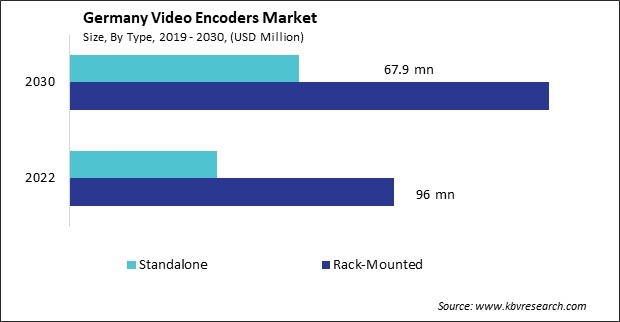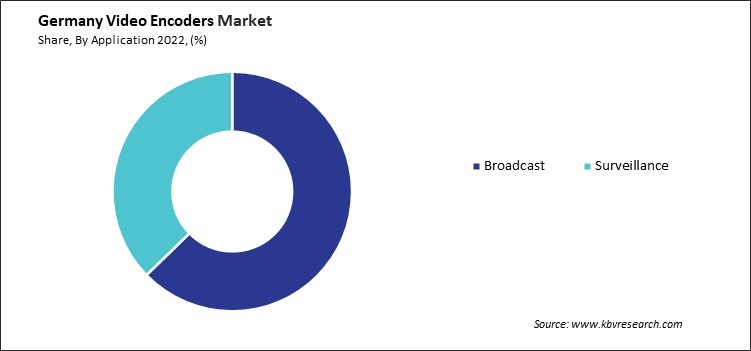Int'l : +1(646) 600-5072 | query@kbvresearch.com
Int'l : +1(646) 600-5072 | query@kbvresearch.com
Published Date : 14-Feb-2024 |
Pages: 91 |
Formats: PDF |
The Germany Video Encoders Market size is expected to reach $209.9 million by 2030, rising at a market growth of 5.3% CAGR during the forecast period. In the year 2022, the market attained a volume of 218.4 thousand units, experiencing a growth of 5.3% (2019-2022).
In Germany, the burgeoning demand for video encoders has been markedly driven by the rapid evolution of digital content consumption habits. With the proliferation of streaming services, there's an insatiable hunger for high-quality video content across the entertainment, education, and business sectors. As a result, companies are investing significantly in robust video encoding technologies to ensure seamless streaming experiences while balancing quality and bandwidth efficiency.

Moreover, the educational landscape has experienced a seismic shift towards digital learning. Germany has been actively fostering digital education initiatives to modernize its educational landscape and equip students with the necessary skills for the digital era. For example, launched in 2019, the DigitalPakt Schule (Digital Pact for Schools) federal-state funding program allocates substantial resources (approximately €5 billion) over several years to equip schools with digital infrastructure. Likewise, developed by the Hasso Plattner Institute, HPI Schul-Cloud is a cloud-based platform focusing on providing secure, user-friendly digital infrastructure for schools. It offers tools for collaboration, learning management, and personalized learning experiences.
Educational institutions heavily rely on video content for lectures, tutorials, and interactive materials. Consequently, there's a growing reliance on advanced video encoding technologies to create, manage, and distribute educational content efficiently.
Germany's broadcast landscape has been witnessing a notable transformation, fueled by the burgeoning demand for video encoders, owing to the proliferation of broadcast services. The rise of streaming platforms, Over-the-Top (OTT) services, and on-demand content has propelled a seismic shift in how audiences consume media. This shift has led traditional broadcasters and new entrants to expand their services, necessitating advanced video encoding technologies to deliver high-quality content efficiently. For instance, public broadcasters like ARD and ZDF, alongside private broadcasters such as ProSiebenSat.1 and RTL, have diversified their offerings to include live streaming, catch-up TV, and exclusive content accessible across multiple devices. The need to cater to diverse audience preferences and the demand for seamless, high-definition content delivery has driven a surge in the adoption of sophisticated video encoders across these platforms.
Furthermore, sports broadcasting stands as a prominent arena driving the demand for video encoders in Germany. The country's fervor for sports, particularly football, has led to an increased emphasis on delivering live events in high resolution and with minimal latency. For instance, the Bundesliga, Germany's top-tier football league, has increasingly relied on innovative encoding technologies to meet the growing expectations of fans for immersive and high-quality viewing experiences. The deployment of advanced encoding solutions has become integral to various industries' strategies, enabling them to deliver immersive, high-resolution, and real-time content, thereby reshaping the landscape of video encoders in the country.
The commercial landscape in Germany has witnessed a notable upswing in the demand for surveillance systems across various sectors. Businesses, ranging from retail establishments and corporate offices to manufacturing plants and healthcare facilities, have increasingly turned to advanced surveillance technologies to address diverse needs.
Beyond security, the need for surveillance systems stems from compliance requirements and liability concerns. Various industries operate under strict regulatory frameworks that mandate security measures. Healthcare facilities, financial institutions, and food service establishments, among others, deploy surveillance solutions to comply with industry-specific regulations, ensuring a secure environment for customers, employees, and assets while mitigating potential liabilities.
As surveillance systems evolve, incorporating advanced features like AI-driven analytics, cloud-based storage, and IoT integrations, the demand for sophisticated video encoders capable of handling diverse video streams efficiently and securely is expected to persist. The symbiotic relationship between the rising demand for surveillance systems and the need for robust video encoding technologies underscores the critical role that video encoders play in enabling effective video surveillance across commercial sectors in Germany.
The proliferation of video conferencing in Germany has played a substantial role in the heightened adoption of single-channel video encoders. As businesses embrace remote work models and seek efficient means of communication, video conferencing has emerged as a cornerstone for virtual collaboration, meetings, and remote interactions.
Video conferencing has extended beyond the corporate world. Educational institutions use it for remote learning, enabling lectures, seminars, and student-teacher interactions. Additionally, telemedicine services have seen an increase in connecting patients with healthcare professionals remotely for consultations and follow-ups.
Companies across Germany are deploying these 1-channel video encoders to enhance their video conferencing infrastructure. They're used in diverse settings, from small businesses to large enterprises, educational institutions, and healthcare facilities. These encoders enable the integration of video feeds from individual cameras or devices, ensuring a smooth and reliable video conferencing experience.

Germany boasts a robust landscape of companies specializing in video encoding technologies, playing pivotal roles in shaping the global video industry. ATEME, a prominent entity, stands as a frontrunner, providing state-of-the-art software-based video compression solutions. Renowned for catering to broadcasters, content providers, and service operators, ATEME's encoding technologies are lauded for their efficiency in delivering high-quality video across various platforms.
Another key player, MainConcept, excels in delivering professional-grade video and audio codecs alongside encoding solutions tailored for diverse industries. Leveraging their expertise in software development kits (SDKs), they cater to broadcasting, streaming, and content creation needs, contributing significantly to the evolving standards of video encoding.
Fraunhofer IIS holds a distinguished position in the field, boasting extensive research and development in audio and multimedia technologies. Widely recognized for its contributions to video coding standards like H.264/MPEG-4 AVC and H.265/MPEG-H HEVC, the institute's advancements in video encoding technologies have profoundly impacted industry standards and innovations.
VITEC is another notable player offering comprehensive video encoding and streaming solutions. With a focus on defense, government, enterprise, and broadcast markets, VITEC delivers hardware and software-based encoding solutions, catering to diverse industry needs with a keen eye on quality and reliability.
Comprimato, specializing in high-performance JPEG2000 and HEVC encoding solutions, serves niche medical imaging and broadcasting industries. Their focus on delivering high-quality video encoding solutions has earned them recognition in sectors requiring top-tier video compression technologies.
These German companies stand as pillars of innovation and excellence in the video encoding domain, consistently pushing boundaries to meet the escalating demands of diverse industries. Their contributions to developing cutting-edge software, standards, and hardware solutions have cemented Germany's position as a leading hub for video encoding technologies on the global stage.
By Type
By Application
By Number of Channel